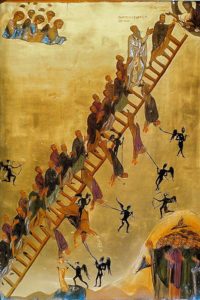
The fourth Sunday of Lent is the Sunday of St John of the Ladder.
Click here for the text of Vespers, Orthros, and the Divine Liturgy variables.
Click here for the Typica service. (When reading Typica instead of attending Liturgy, you will need both the Typica and Divine Liturgy texts.)
Lenten Sunday Vespers is here.
Theme
On the Fourth Sunday of Holy Lent the Orthodox Church commemorates our Righteous Father John Climacus. He is called Climacus due to his authorship of the great spiritual work The Ladder of Divine Ascent. His commemoration is designated by the Church on one of the Sundays of Lent as his life and writings affirm him as a supreme bearer and proponent of Christian asceticism. The ascetic example of this great Saint of the Church inspires us in our Lenten journey.
Observance of the Week
The feast day of Saint John Climacus is March 30, however, due to the popularity of the Saint and the practice of not having weekday Divine Liturgies during Great Lent, the Orthodox Church commemorates the Saint on the Fourth Sunday of Lent. As a Sunday of Great Lent, the commemoration is celebrated with the Divine Liturgy of Saint Basil the Great, which is preceded by a Matins (Orthros) service. A Great Vespers is conducted on Saturday evening.
Story
John, dead in the flesh and also living,
Liveth eternally, even though appearing dead and without breath.
Leaving letters, a ladder for the journey upwards,
He showeth forth his pursuit of the journey upwards.
The celebration of his feast on this day arose from the custom prevalent in the honorable monasteries of starting Great Lent with the reading of his lessons. John describes the method of elevating the soul to God as ascending a ladder. He teaches those who seek salvation how to lay a firm foundation for struggles, how to detect and fight every passion, how to avoid demonic snares, and how to rise from the rudimentary virtues to the heights of Godlike love and humility. John of the Ladder came to Mount Sinai at age 16 and remained there, first as a novice under obedience, then as a recluse, and finally as abbot until his eightieth year. One time, his disciple, Moses, fell asleep under the shade of a large stone. John, in prayer in his cell, saw that his disciple was in danger and prayed to God for him. Later, when Moses returned, he fell on his knees and gave thanks to his spiritual father for saving him from certain death. He related how, in a dream, he heard John calling him and he jumped up and, at that moment, the stone tumbled. Had he not jumped, the stone would have crushed him.